Galangal is a medicinal and aromatic plant related to ginger. We show what to consider when growing galangal in the pot and in the garden.
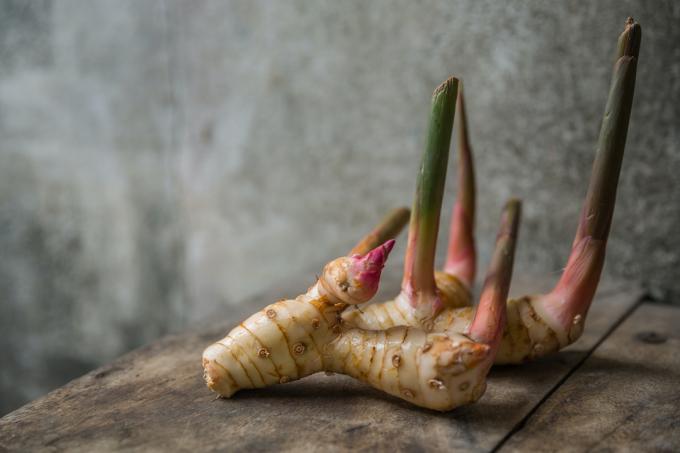
Galangal (Alpinia) comes from the tropics of Southeast Asia and gained great fame and popularity as a medicinal and aromatic plant hundreds of years ago in Europe. We present the ginger-like plant in a profile and give tips on the culture and healing properties of galangal.
contents
- What is galangal?
- Planting galangal
- Proper care
- Is galangal hardy?
- Multiplication
- Harvest and storage
- What is the effect of galangal?
- Use of galangal
What is galangal?
Two different but closely related plants are known under the name galangal: The small or real galangal (Alpiniaofficinarum) as a medicinal plant as well as the Thai ginger or great galangal (Alpiniagalanga) as a spice. Both belong exactly like ginger (Zingiber officinalis) to the ginger family (Zingiberaceae), for which the subterranean, thickened rhizomes and the pungent taste are particularly characteristic. Galangal probably got through Arab doctors and merchants from the 9th Century AD Chr. from Southeast Asia to Europe. From the 11th Century mentioned as a medicinal plant in herbal books of various monasteries. Hildegard von Bingen devoted a whole chapter on galangal in her text "Physica" to this ginger plant.
The real or small galangal is also known as fever root and reaches a height of 100 - 150 cm, while the large galangal can grow up to 3 m high. The perennial perennials form richly branched root systems underground with fleshy rhizomes up to 4 cm thick. Depending on the species, they are reddish-brown to pale yellow in color. Several upright stems grow from them with up to 50 cm long, broadly lanceolate, glossy green and white spotted leaves. The young shoots have one cardamom (Elettaria cardamomum) reminiscent aroma. In a tropical climate, fragrant, grape-like, downy inflorescences with white-red galangal flowers develop. In their homeland, round red fruit capsules up to 1.5 cm in size develop, which serve as a spice. Inside there are numerous wrinkled, brown-black seeds.
What is the difference between galangal and ginger? Galangal and ginger are closely related and both form underground rhizomes, which are among the most important spices in Asian cuisine. The taste of both plants differs significantly, as galangal tastes hotter. There are also externally differences: the rhizomes of the ginger are light brown in color and irregularly thickened like a club, while the galangal roots are rather elongated and reddish.
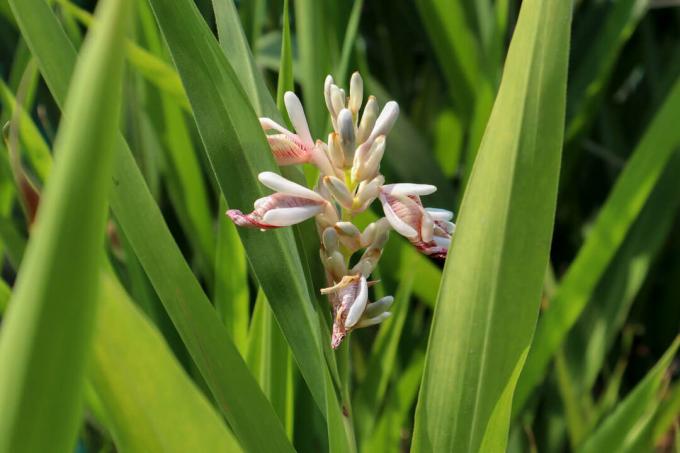
Planting galangal
The optimal location for galangal is on well-drained, nutrient-rich soils with a slightly acidic pH. If you want to plant galangal, you need a light to partially shaded, very warm and protected place with high humidity. In late summer, the temperature fluctuations between day and night can become a problem, because it should not be cooler than 15 ° C. In our latitudes, only a heated greenhouse or a polytunnel is actually suitable for growing galangal, or alternatively a pot in a sunny winter garden. Galangal is rarely available as a whole, dried rhizome and in specialist nurseries as a potted plant.
If you want to grow galangal in a pot, it should contain at least 10 liters of soil volume so that the rhizomes have enough space to develop. The planter used should always have good water drainage and a height of 5 - 10 cm Have a drainage layer, as too much moisture or even waterlogging lead to rot of the rhizome can. Now fill in a nutrient-rich potting soil like ours Plantura organic universal soil in the pot. The peat-free and compost-rich substrate provides all the important nutrients in the rooting phase and is produced sustainably and climate-friendly in Germany. Plant the rhizome about 5 cm deep in the ground and water it well. Specimens that have already been potted should not be placed deeper than they were previously in the pot. When growing galangal in a heated greenhouse, a planting distance of 30 - 40 cm should be maintained.
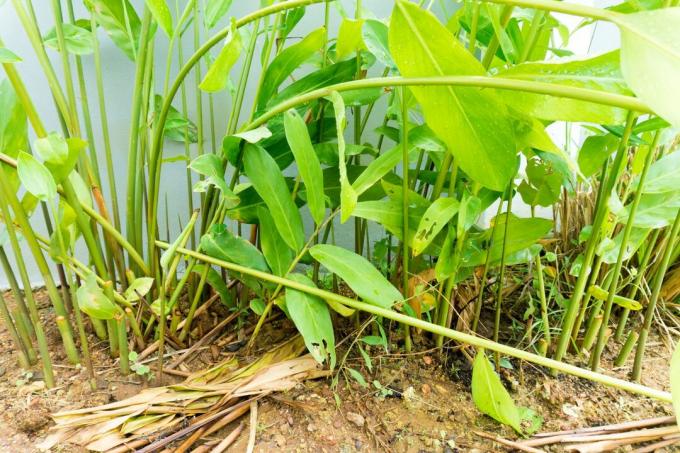
Proper care
Even if the rhizome has to be protected from waterlogging, the galangal should still be watered regularly. In summer you have to water almost every day, as the plant needs a lot of water. However, water should only be given when the surface of the earth has dried off a bit. The humidity should also always be kept high, for example with the help of a spray bottle. Regular fertilization cannot be dispensed with due to the high nutrient requirements of galangal. A good supply of nutrients is particularly important during the main growing season and when leaves or rhizomes are harvested. The potted plant should be regularly fed an organic liquid fertilizer such as ours Plantura organic indoor & green plant fertilizer, be fertilized. This is added to the irrigation water about every two weeks during the growing season, what a uniform and provides a gentle supply of nutrients and symptoms of deficiency such as yellow leaves or the browning of the leaf edges prevented. At the same time, the liquid fertilizer comes to you in sustainable packaging made from 95% recycled plastic.
Is galangal hardy?
Galangal is not hardy and suffers from cold stress from temperatures below 15 ° C. Potted plants should therefore be moved to warm winter quarters as early as September. In the apartment in a bright but protected place without drafts and with high humidity, it is possible to overwinter the galangal. In winter, the need for water often drops significantly, so it must be ensured that the soil is never too moist. Fertilization should also be avoided in the winter months.
Multiplication
In order to propagate galangal itself, only part of the rhizome with an eye is required. This piece of the subterranean shoot axis is put about 5 cm deep into loose, nutrient-rich substrate in spring. Larger plants can also be easily divided by dividing the rhizomes with disinfected, sharp secateurs so that each one sprout with roots remains. After about three to four weeks, the first new shoots with leaves stretch upwards. Repotting is always necessary when the galangal plant has well rooted the planter. It is also possible to grow imported galangal seeds from exotic shops. Before sowing, the seeds should be allowed to soak in water for a day before they are sown about 0.5 cm deep in nutrient-poor potting soil.

Harvest and storage
If you grow galangal, you have to be patient until you can harvest. In their tropical and subtropical homeland, it takes from planting the rhizome parts to harvesting the Galangal rhizomes about three months, in which case the entire plant is cleared and not cultivated for several years will. In our part of the world, it takes significantly longer, sometimes several years, for sufficiently large rhizomes for harvesting Galangal have formed, if the galangal does not only find a place as a decorative tropical plant on the terrace or balcony target. During harvest, the rhizomes are removed from the earth, the shoots cut off and the galangal roots cleaned.
The rhizomes keep fresh in the refrigerator for two to three weeks after harvest. For a longer shelf life, it helps to wrap the harvested subterranean sprouts in cling film or a damp cotton cloth, as this further reduces water loss. The galangal can be preserved for several months by drying. However, it should be cut into thin slices for quick drying. When dry, it can also be processed into galangal powder.
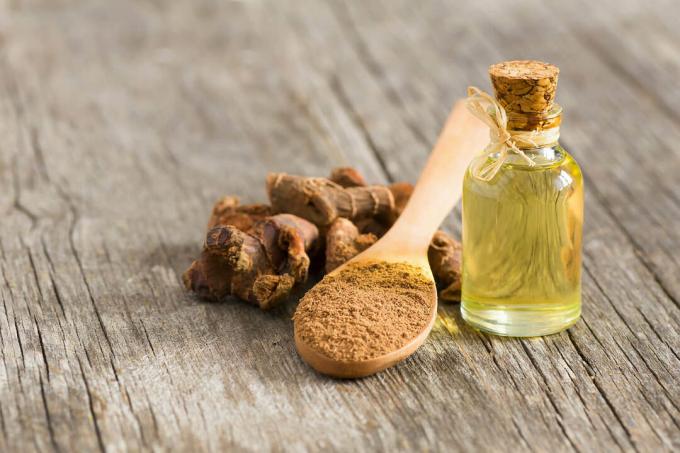
What is the effect of galangal?
More than a thousand years ago, the ginger plant was known in ancient China for its beneficial properties. Galangal is part of Ayurvedic treatment and is used in natural medicine as well as TCM. The positive effect of galangal on blood pressure, heart and circulation has already been described by Hildegard von Bingen. She recommended galangal wine to be taken in pain. In addition, the ginger plant has an antispasmodic, antibacterial, stimulating and digestive effect. However, pregnant women should exercise caution: Excessive consumption can possibly lead to miscarriage or premature birth. Galangal should also not be used for stomach and duodenal ulcers, as it increases the production of stomach acid. Galangal is taken in the form of powder, capsules, galangal root tea, globules or galangal tincture. Side effects of galangal are not known with normal dosage and use of the preparations.
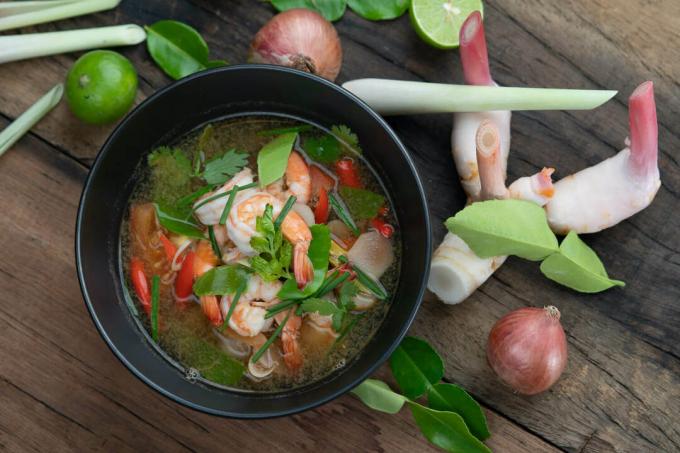
Use of galangal
The two types of galangal enjoy different uses. Thai ginger is used in Asian cuisine as a galangal spice in ground or chopped form. Its taste is similar to that of ginger, but a bit spicier. Galangal is part of the typical cola aroma and is contained in many liqueurs and schnapps to aid digestion. The real galangal is also used as a spice in the form of galangal powder or freshly cut rhizome parts.
In addition to the ginger, galangal is also associated with the turmeric (Curcuma longa) related. In our portrait you will find helpful tips and information on planting, caring for and harvesting turmeric.



